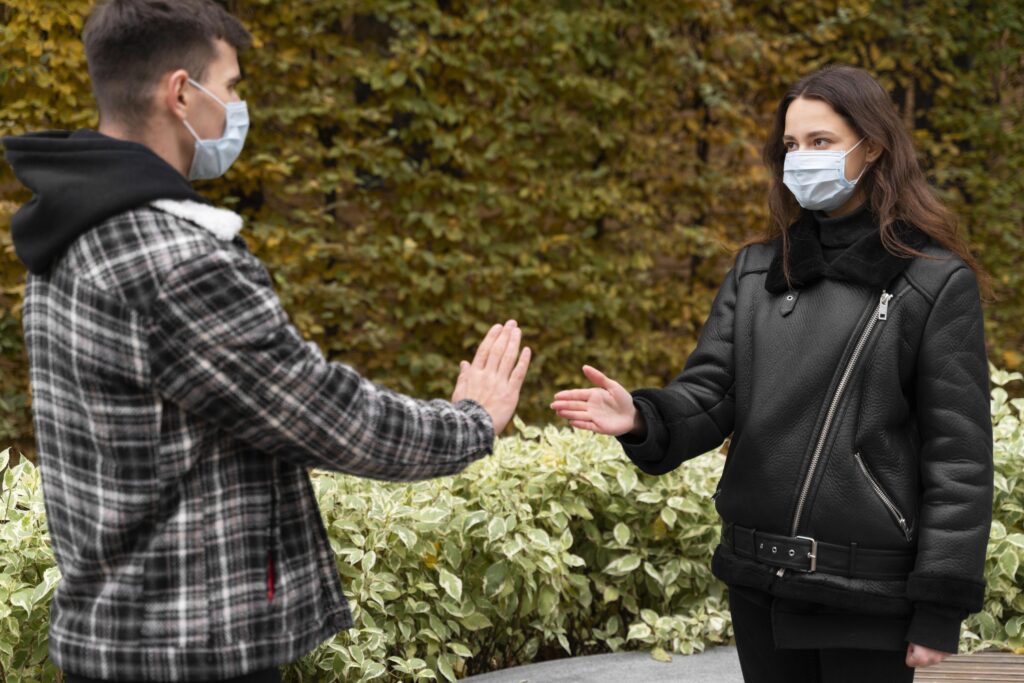Lungs are the major organs of the respiratory system and are linked with the nasal cavity and mouth through a windpipe. From the windpipe to the lungs, air is delivered through bronchial tubes. Swollen or inflamed bronchial tubes are referred to as bronchitis and make their flow difficult through bronchial tubes to and from the lungs. Due to the blockage of air passage and difficulty in breathing, people often confuse the two diseases i.e. Bronchitis and Common Cold. A comparison between bronchitis and the common cold is also explained in this article which may help you to differentiate the one from the other.
Introduction to Bronchitis
Bronchitis is categorized as acute and chronic bronchitis. The former is common and often people take bronchitis as an acute form.
Symptoms of both forms are similar but in chronic bronchitis, the symptoms like cold, chills, or fever don’t appear and a nagging cough is considered as a hallmark sign of chronic bronchitis.
Keep on reading to learn more about the signs, symptoms, causes, and treatment of bronchitis. A comparison between bronchitis and the common cold is also explained in this article which may help you to differentiate the one from the other.
Early Symptoms of Bronchitis
Bronchitis damages the airways like bronchioles and bronchi thus making it harder to pass air in and out of your lungs. This is because of aggravation of lung tissues and accumulation of mucus in the lungs.

Bronchitis, initially, is just characterized as a dry cough that soon turns into a productive cough, which means a cough with a clear, yellowish, white, or greenish mucus.More symptoms of bronchitis include:
- Wheezing sound with cough.
- Shortness of breath.
- Fatigue and tiredness.
- Chest congestion.
- Sore throat.
Acute bronchitis, however, has some prominent symptoms including, chills, body aches, fever, and headache that differentiate it from the chronic form.
Is Cough a Major Symptom?: It is the symbolic representation of bronchitis. At the start, coughing is dry but as the condition becomes more serious the cough turns into reproductive and you may cough with mucus. In some cases, other symptoms may resolve but the cough may linger.
Discharging Mucus: At the initial stage, the color of mucus is white but as the condition progresses it turns into yellow or green. That indicates the inflammatory cells have reached your airways which might be a sign of danger. Some people take it as a bacterial infection but in reality, it is not just a bacterial invasion it is the start of airway destruction.
Adults vs. Children Symptoms
Symptoms of bronchitis in children are similar to adult symptoms but most children also experience gagging or vomiting during coughing.
Difference Between Acute and Chronic Bronchitis
Bronchitis is a result of a viral or bacterial infection and most people develop it after a viral or bacterial invasion. Some allergens like dust fumes and smoke are also responsible for bronchitis. The symptoms usually become mild but last for several weeks.
Chronic Bronchitis is a result of repeated bronchitis attacks that come along with a productive cough and lasts for three to four months. The recurring episodes also last for two to three years. Smoking is another cause of chronic bronchitis. So it is right to say that if you have frequent episodes of acute bronchitis you may go on to develop chronic bronchitis.
An Overview of Common Cold
Common cold being an upper respiratory infection damages your trachea (windpipe), sinuses, throat, and nose. Recent studies support the idea that the common cold is a type of coronavirus because more than 200 various types of viruses are responsible for causing the common cold. According to research, the most common cold virus is known as Rhinovirus.
Common cold as its name elaborates, is a widespread infection. You may have more colds in your life than other illnesses.
Symptoms of Bronchitis and Common Cold
Although the symptoms of bronchitis and the common cold are similar, they have clear difference as lower respiratory infection and upper respiratory infection.
Symptoms of Bronchitis
According to the Lung Association in the USA, common symptoms of bronchitis (acute or chronic) include:
- Productive cough.
- Wheezing sounds while breathing through your nose.
- Runny nose.
- Fatigue.
- And fever with chills.
Symptoms of Common Cold
The common cold usually affects your throat and nose. Viruses usually cause common colds. Initially, it seems harmless but often it might not feel that. Generally, adults in our region experience two to three common colds a year but infants and young kids often get common colds. Its symptoms usually occur in different stages. These are three stages:
- Early Stage (First Three days).
- Active Stage (3rd to 7th day).
- Late Stage ( 8th to 10th day).
Early Stage ( Stage 1) Initially, you feel a tickle in your throat and in the first one to three days of picking up a common cold you experience the soreness in your throat. This is the most common and the very first symptom that most people experience. The early stage is also diagnosed due to some other symptoms like sneezing with a runny or stuffy nose, irritating hoarseness and cough.
Initially, you feel a tickle in your throat and in the first one to three days of picking up a common cold you experience the soreness in your throat. This is the most common and the very first symptom that most people experience. The early stage is also diagnosed due to some other symptoms like sneezing with a runny or stuffy nose, irritating hoarseness and cough.
Active Stage (Stage 2)
During active or second stage common cold symptoms get worse and some more symptoms are added like:
- Headaches with painful body aches.
- Runny eyes
- Ear pain.
- Difficulty in breathing.
- Swollen glands.
- Difficulty in swallowing.
- Fatigue and blurriness.
Late Stage ( Stage 3)
During this stage, the common cold begins to wind down. You may feel like recovering at this point but some symptoms may linger like coughing. Often people develop a nagging cough that may persist for two to three months after the infection.
If you feel more dull and symptoms continue to worsen, plan a visit to your doctor. Because the persistent symptoms sometimes are the signals of other serious infections or complications such as bronchitis, pneumonia, or sinusitis.
Generally, you can recover from a common cold within 7 to 10 days. Some symptoms may last for several days after recovery. For example, people who smoke are more likely to get affected by the common cold and recovery is a time-consuming process for them. No medical care or medication is useful for its treatment but in case of worsening the symptoms, you can see your healthcare provider. It is called upper respiratory infection because the illness affects the nose and throat.
Smoking is the cause of persistent symptoms. Generally recovery period starts after 5 to 7 days. Most often, you don’t need medical care for a common cold. If symptoms don’t get better or if they get worse, see your healthcare provider. It starts with a sign of sore throat, or tickle in your throat. Other symptoms include:
- Coughing.
- Hoarseness.
- Nasal irritation.
- Sneezing.
These are all the symptoms that appear at the early stages of the common cold but as the condition progresses the symptoms turn into more severe conditions including:
- Recurring episodes of fever.
- Body aches with fatigue.
- Headaches or migraines.
With time symptoms may dissipate but cough may linger for several weeks.
Causes of Common Cold vs. Bronchitis
Bronchitis and common old are the respiratory infections for which the viruses are recognized as pesky culprits. Thus the causative agents are the same for both. Some more causes for both are:
Causes of Bronchitis
Viruses are the common causative agents for bronchitis but sometimes a bacterial infection also leads to a case of acute bronchitis. Irritating substances in air or breathing in the presence of irritating allergen for lungs also causes bronchitis. These irritating substances may be dust, smoke, or pollutants.
Causes of Common Cold
Research has been done at the Center for Disease Control and Prevention in the USA. Researchers concluded that the major and basic cause of common cold is rhinovirus but other culprits are:
- Enterovirus.
- Adenoviruses.
- Common human coronaviruses.
- Parainfluenza viruses.
The Incubation Period for the Common Cold Virus: Its incubation starts from the time of getting infected to the time of the appearance of symptoms. It can prolong to 24 hours to three days after getting the virus.

Why is the Common Cold Contagious?: Common cold spreads easily from person to person. When a virus gets into one of your mucus membranes, your nostrils, eyes, or mouth can get infected. It usually happens when you get in touch with a surface that has the germ or breathes in air that contains the causative agent.The process of spreading the common cold starts when a person who’s ill, coughs and launches droplets of fluid full of common cold viruses into the surroundings. If these droplets reach your mouth and nose through breathing, they take root in your nose and the infection spreads. You are also responsible for its spread because your touch leaves particles of the virus on the surfaces. Whoever touches those surfaces the virus may get into their respiratory tract.
So be careful and stop spreading the infection. Because you will be contagious for two to three weeks after getting affected.
Risk Factors for Bronchitis and Common Cold
Here are the risk factors for both illnesses because some people are at greater risk for certain infections than others. So it is good to know about irrelevant risk factors. Let’s take a look!
Risk Factors for Bronchitis
It can happen to anyone but the chances of getting infected by bronchitis are higher if you recently experienced a bacterial or viral infection. Older people and young children are more likely to get infected by bronchitis. People with underlying health issues such as heart disease, lung disease, or asthma, and smokers are easily captured by this viral infection.
Risk Factors for Common Cold
It is a common illness and everyone gets caught by the common cold one to two times during a year. But the infection is more common in winter. Usually, children and older persons catch more colds than healthy adults. Other risk factors include smoking, stress, and lack of sleep. A weak immune system also makes you vulnerable to catching a cold.
When to See a Doctor?
Recurring episodes of symptoms in bronchitis or common cold are signs of complicated conditions. Therefore, in case of worsening symptoms, you must plan a visit to your doctor.
Diagnostic Procedure: Doctors or healthcare providers start diagnostic procedures by asking some questions about the symptom appearance and duration for that they have lasted for. They will also review your medical history and then prescribe some tests like a CT X-ray or more.
Treatment of Bronchitis and Common Cold
Mild cases of bronchitis and common cold are usually treated by similar methods.

Treatment for Bronchitis
In most cases, the symptoms of acute bronchitis usually go away on their own, without any medication or treatment but sometimes it becomes necessary to manage the symptoms and it can be done by:
- Taking a rest.
- Maintaining moisture in the air to remove chest congestion.
- Drinking more water or liquids.
- Using pain reliever (OTC) to suppress cough.
Treatment for Common Cold
You may focus on the symptoms because there’s no fixed cure for the common cold. Its symptoms may prolong to two to three weeks. So you can deal with these symptoms by taking enough rest, drinking plenty of liquids and water, and taking OTC medications.
Prevention of Bronchitis or Common Cold
Avoiding germs is the best way to prevent these infections. You can avoid germs that cause bronchitis and cold by being vigilant about washing hands and using gloves or a face mask.
Bronchitis is a viral disease and it isn’t caused by bacteria, therefore antibiotics are not effective for its remedy instead of antibiotics but shortness of breath and recurring episodes of cough are common in both infections. Antibiotics have side effects that damage your overall health.
Conclusion
Your common cold may turn into a mild type of bronchitis because cough, sneezing, shortness of breath, chest congestion, and fever are common symptoms in bronchitis and common cold. Therefore, in case you get a common cold and worsen the symptoms, you must contact your doctor to evaluate the condition.







